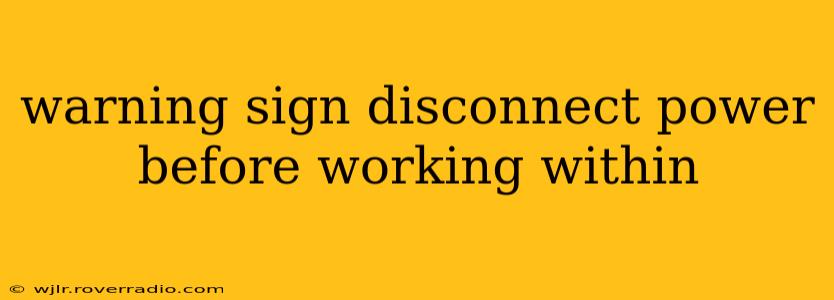Working with electrical systems presents inherent risks. A simple yet crucial safety precaution, often highlighted by a prominent warning sign, is to disconnect power before working within any electrical equipment or panel. This seemingly straightforward instruction is paramount to preventing severe injuries, fatalities, and property damage. This guide delves into the importance of this warning, exploring various scenarios, safety measures, and frequently asked questions surrounding electrical safety.
Why is Disconnecting Power So Crucial?
The risk of electrical shock is the primary reason for this critical safety measure. Even seemingly "deactivated" systems can retain residual voltage, capable of delivering a lethal shock. Furthermore, working on energized equipment increases the likelihood of:
- Electric shock: Contact with live wires can cause burns, muscle spasms, cardiac arrest, and even death. The severity depends on the voltage, current, and duration of contact.
- Arcing and fires: Faulty wiring or accidental contact can create electrical arcs, generating intense heat and potentially igniting flammable materials.
- Equipment damage: Working on live equipment can damage components, potentially leading to costly repairs or complete system failure.
Ignoring this warning can have devastating consequences, ranging from minor injuries to catastrophic events.
What Types of Work Require Power Disconnection?
The "disconnect power before working within" warning applies to a wide range of situations, including but not limited to:
- Electrical panel work: Any maintenance, repair, or installation within an electrical panel requires complete power disconnection.
- Wiring repairs: Before working on any wiring, whether it's in walls, ceilings, or appliances, always disconnect the power.
- Appliance repair: Even seemingly simple appliance repairs should be performed only after disconnecting the power source.
- Working with electrical motors: Before any work on electrical motors, generators, or other rotating electrical equipment, ensure power is completely disconnected and locked out.
How to Properly Disconnect Power
Simply turning off a circuit breaker or unplugging an appliance isn't always sufficient. Follow these steps for safe power disconnection:
- Lockout/Tagout: Use a lockout/tagout system to physically lock the power source, preventing accidental re-energization. This is especially critical in industrial settings.
- Verify Power is Off: Always use a non-contact voltage tester to confirm the power is off before commencing any work. Never rely solely on visual inspection or circuit breakers.
- Grounding: Grounding the equipment further reduces the risk of electrical shock by providing a safe path for any residual electricity.
What if I Accidentally Touch a Live Wire?
Accidental contact with a live wire can be life-threatening. If this happens:
- Break contact immediately: Use a non-conductive material (like dry wood or plastic) to separate yourself from the live wire. Never use metal objects.
- Seek immediate medical attention: Even minor shocks can have long-term health effects. Get professional medical evaluation as soon as possible.
Can I Work on Electrical Equipment Without Disconnecting Power?
While some specialized professionals might perform limited work on live equipment under specific, controlled conditions, this is generally not recommended for the average person. The risks significantly outweigh any potential time savings. Always prioritize safety and disconnect power before working within any electrical system unless you are a highly trained and qualified electrician working under strict safety protocols.
What are the legal implications of ignoring this warning?
Ignoring the "disconnect power before working within" warning can lead to serious legal repercussions, especially in workplace settings. Employers have a legal obligation to provide a safe working environment, and failing to adhere to safety protocols can result in hefty fines and potential lawsuits.
This guide highlights the critical importance of adhering to the "disconnect power before working within" warning. Remember, electrical safety is paramount. Prioritize safety over speed and always follow the proper procedures to mitigate the risks associated with working with electrical systems. If you're unsure about any aspect of electrical safety, seek guidance from a qualified electrician.
